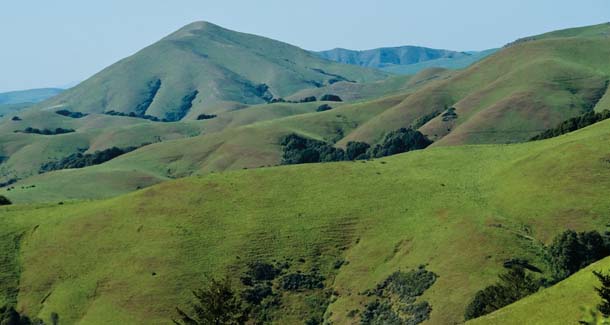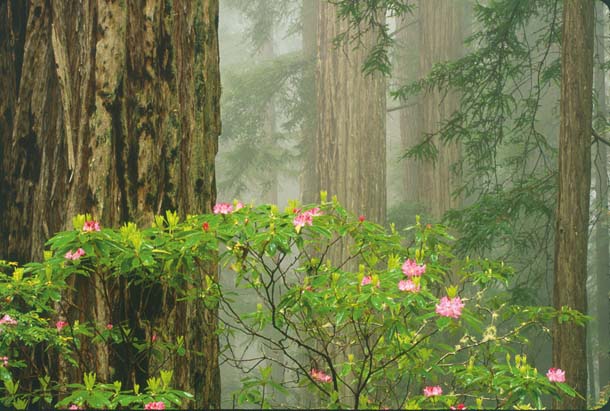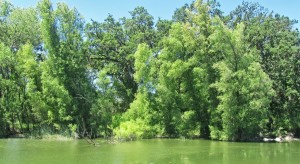On a frosty January morning, Rose Blackburn is raising the flag at the entrance to Samuel P. Taylor State Park. With a radio on one hip and a pistol on the other, the small, trim woman cheerfully waves in the first car of the day.
In Marin County just north of San Francisco, Taylor is best known for first-class camping in a fern-filled redwood forest. Its trees aren’t as lofty as those on the North Coast, but–with at least one redwood over 90 meters–they’re taller than those at the more celebrated Muir Woods National Monument a few miles to the south. Taylor shelters rare wildlife, too, with spotted owls and freshwater shrimp and (even rarer on the Central California coast) a small but ecologically significant run of steelhead trout and coho salmon.
Today, supervising ranger Blackburn has agreed to take a reporter on a sort of victory lap around the park. On the closure list in May, Taylor won removal in September, thanks to some creative thinking by local state park staff and a neighbor, the National Park Service. “I heard Taylor was saved,” one visitor exults. “We got a temporary reprieve,” Blackburn says.
- A couple of girls enjoying the waters of Lagunitas Creek on a warm summer day. Photo © Kathleen Goodwin.
Like most parks on the list, Taylor was probably targeted for financial reasons. About 130,000 people come each year and pay over $500,000 in day-use and camping fees, but that’s only about half the current cost of running the park. Taylor’s picnic areas and 61 campsites are popular. But they can’t accommodate many people, and numerous access points enable many visitors to avoid the $8 day-use fee.
Even before the closure crisis, Taylor was 50 percent below full staffing levels–compensating partly by closing down for two or three days a week in the winter. The public was mostly unaware of this whittling away of staff, but the ax of closure “got a lot of attention,” Blackburn says–including from the managers of the Golden Gate National Recreation Area (GGNRA), which surrounds Taylor on three sides. Frank Dean, general superintendent of GGNRA, was worried that closure “could create use pressures and unacceptable threats.” So the two parties came up with a solution to keep the park open.
Starting in January 2012, Muir Woods–which draws six times as many visitors as Taylor–boosted its $5 entrance fee to $7. The extra money will provide approximately $475,000 dollars to keep Taylor open at least five days a week. It will also beef up the budget of Mount Tamalpais State Park (not on the closure list, but in the same watershed as Muir Woods) and enable restoration of Redwood Creek, which flows from Mount Tamalpais through Muir Woods to the Pacific Ocean at Muir Beach in the GGNRA. State and federal lands will both benefit.
The state and the feds have been informally helping each other for years in Marin County, where their lands are thoroughly intertwined. For example, the overflow parking lot at Muir Woods is on state land. Another national park unit, Point Reyes National Seashore, surrounds Tomales Bay State Park, which was thrown a different type of federal lifeline in September. While Taylor will be run by the state, the National Seashore will collect fees and take over operations at Tomales Bay.
When the closure of Taylor was first announced, Petaluma-based Lagunitas Brewing Company offered its own proposal to save the park. The firm’s founder, Tony McGee, believed that he could run Taylor more efficiently than the state. What it would take, he said, was some help from the sheriff and a business-savvy nonprofit staffed by enthusiastic volunteers and less highly trained, lower-cost staff.

- Trails at Samuel P. Taylor ascend from the redwood forest along the creek into the open grassland hills of West Marin. Photo by Eliya Selhub.
Some cheered that entrepreneurial option. But others breathed a sigh of relief when the National Park Service came to the rescue. In August 2011, Marin Community Foundation president Tom Peters and state Assembly member Jared Huffman (D-San Rafael) had formed the Marin Open Parks Coalition to address closures at Taylor and three other Marin state parks–China Camp, Tomales Bay, and Olompali. Ideally, Peters said, the coalition was looking for solutions “that allowed professional park authorities to maintain these complex resources,” so the federal support option was preferable.
But that’s not the end of the story. As Blackburn said, this is a temporary reprieve. The money from Muir Woods, plus camping and day-use fees, should keep the park operating through June 2013. But then the contract needs to be renewed.
Blackburn hopes to have the park on a firmer footing by the time that date rolls around. “The deal is designed to keep us where we’re at, which is not optimal,” Blackburn says. “But maybe if we come up with some great income-producing ideas and efficiencies, it will be different.”
For starters, Blackburn hopes to bolster Taylor’s volunteer committee, part of the nonprofit Marin State Parks Association (which is also working to keep Olompali and China Camp from closing). She’s also reassessing her use of volunteer campground hosts. In exchange for a free RV space, they work 20 hours a week, helping at the entrance, selling firewood, answering visitors’ questions, and handling late-night emergencies. In peak season, she now has two campground hosts. She may expand that to three or four, with one host concentrating on maintenance. One surefire revenue enhancement is a new lodging option: five new primitive cabins that she hopes will be ready for visitors this spring, at $100 a night or so (compared with $35 for a campsite).
As Blackburn shows the reporter around, she squeezes in other tasks: making change at the entrance, telling people how to get to various trailheads, asking a couple to leash a dog, and sending a maintenance person out to clear a tree that’s fallen over a trail. After a couple of hours, though, she glimpses her watch. The park she’s been describing, with higher revenues and lower costs, is still theoretical. In the here and now, it’s midweek–time to go shut down the campground.

- A rhododendron blooms in the forest at Del Norte Coast Redwoods. Photo by Alan Justice.
Federal Help for Del Norte as Well
Del Norte Coast Redwoods State Park is part of a complex of parks in the northwestern corner of California that shelter and showcase the world’s tallest trees. Redwood National Park has the most acreage. But the three state parks–Del Norte Redwoods, Prairie Creek Redwoods, and Jedediah Smith Redwoods–have all the campgrounds and some of the most magnificent redwoods. All four parks in Redwood National and State Parks share the same visitor center and host 45 percent of the state’s remaining old-growth redwoods.
When Del Norte showed up on the closure list in May, national park officials had some of the same concerns voiced at Samuel P. Taylor and Tomales Bay state parks. A shuttered park would be attractive for illegal drug cultivation, endangering resources and visitors. Trails would fall into disuse. Campground capacity would shrink. Thefts of sections of downed redwoods, already a problem on the North Coast, would likely increase.
So starting in September 2011, the state and the feds entered into a one-year agreement in which the National Park Service has taken over most responsibilities for operating Del Norte. While not providing any additional funding or taking responsibility for infrastructure repairs, the agency is keeping the park’s campground and most of its 31,000 acres open. “This will mean that some national park trails and facilities will get less attention,” said an agency press release in October, “but closure would likely diminish the quality of visitors’ experiences in the entire complex.”

.jpg)




